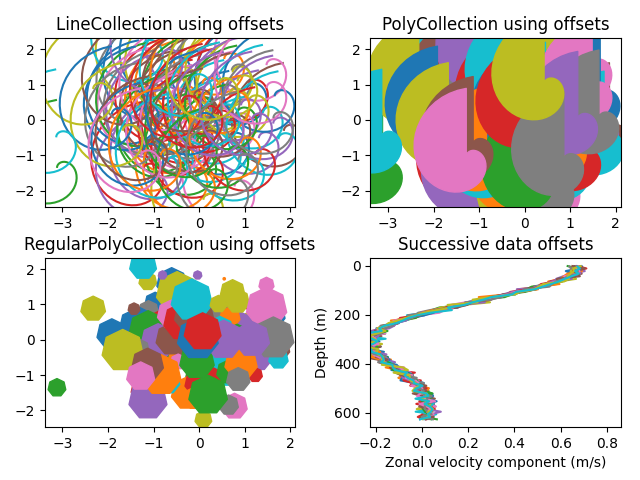메모
전체 예제 코드를 다운로드 하려면 여기 를 클릭 하십시오.
자동 크기 조정 기능이 있는 Line, Poly 및 RegularPoly 컬렉션 #
처음 두 서브플롯에는 나선형을 사용합니다. 크기는 데이터 단위가 아닌 플롯 단위로 설정됩니다.
해당 위치는 및 의 offsets 및 offset_transform 키워드 인수를 사용하여 데이터 단위로 설정됩니다 .LineCollectionPolyCollection
세 번째 서브플롯은 처음 두 개의 서브플롯과 동일한 유형의 스케일링 및 위치 지정을 사용하여 일반 다각형을 만듭니다.
마지막 서브플롯은 "offsets=(xo, yo)"의 사용을 보여줍니다. 즉, 튜플 목록 대신 단일 튜플을 사용하여 오프셋이 데이터 단위로 지정된 연속 오프셋 곡선을 생성합니다. 이 동작은 LineCollection에만 사용할 수 있습니다.
import matplotlib.pyplot as plt
from matplotlib import collections, colors, transforms
import numpy as np
nverts = 50
npts = 100
# Make some spirals
r = np.arange(nverts)
theta = np.linspace(0, 2*np.pi, nverts)
xx = r * np.sin(theta)
yy = r * np.cos(theta)
spiral = np.column_stack([xx, yy])
# Fixing random state for reproducibility
rs = np.random.RandomState(19680801)
# Make some offsets
xyo = rs.randn(npts, 2)
# Make a list of colors cycling through the default series.
colors = [colors.to_rgba(c)
for c in plt.rcParams['axes.prop_cycle'].by_key()['color']]
fig, ((ax1, ax2), (ax3, ax4)) = plt.subplots(2, 2)
fig.subplots_adjust(top=0.92, left=0.07, right=0.97,
hspace=0.3, wspace=0.3)
col = collections.LineCollection(
[spiral], offsets=xyo, offset_transform=ax1.transData)
trans = fig.dpi_scale_trans + transforms.Affine2D().scale(1.0/72.0)
col.set_transform(trans) # the points to pixels transform
# Note: the first argument to the collection initializer
# must be a list of sequences of (x, y) tuples; we have only
# one sequence, but we still have to put it in a list.
ax1.add_collection(col, autolim=True)
# autolim=True enables autoscaling. For collections with
# offsets like this, it is neither efficient nor accurate,
# but it is good enough to generate a plot that you can use
# as a starting point. If you know beforehand the range of
# x and y that you want to show, it is better to set them
# explicitly, leave out the *autolim* keyword argument (or set it to False),
# and omit the 'ax1.autoscale_view()' call below.
# Make a transform for the line segments such that their size is
# given in points:
col.set_color(colors)
ax1.autoscale_view() # See comment above, after ax1.add_collection.
ax1.set_title('LineCollection using offsets')
# The same data as above, but fill the curves.
col = collections.PolyCollection(
[spiral], offsets=xyo, offset_transform=ax2.transData)
trans = transforms.Affine2D().scale(fig.dpi/72.0)
col.set_transform(trans) # the points to pixels transform
ax2.add_collection(col, autolim=True)
col.set_color(colors)
ax2.autoscale_view()
ax2.set_title('PolyCollection using offsets')
# 7-sided regular polygons
col = collections.RegularPolyCollection(
7, sizes=np.abs(xx) * 10.0, offsets=xyo, offset_transform=ax3.transData)
trans = transforms.Affine2D().scale(fig.dpi / 72.0)
col.set_transform(trans) # the points to pixels transform
ax3.add_collection(col, autolim=True)
col.set_color(colors)
ax3.autoscale_view()
ax3.set_title('RegularPolyCollection using offsets')
# Simulate a series of ocean current profiles, successively
# offset by 0.1 m/s so that they form what is sometimes called
# a "waterfall" plot or a "stagger" plot.
nverts = 60
ncurves = 20
offs = (0.1, 0.0)
yy = np.linspace(0, 2*np.pi, nverts)
ym = np.max(yy)
xx = (0.2 + (ym - yy) / ym) ** 2 * np.cos(yy - 0.4) * 0.5
segs = []
for i in range(ncurves):
xxx = xx + 0.02*rs.randn(nverts)
curve = np.column_stack([xxx, yy * 100])
segs.append(curve)
col = collections.LineCollection(segs, offsets=offs)
ax4.add_collection(col, autolim=True)
col.set_color(colors)
ax4.autoscale_view()
ax4.set_title('Successive data offsets')
ax4.set_xlabel('Zonal velocity component (m/s)')
ax4.set_ylabel('Depth (m)')
# Reverse the y-axis so depth increases downward
ax4.set_ylim(ax4.get_ylim()[::-1])
plt.show()

참조
다음 함수, 메서드, 클래스 및 모듈의 사용이 이 예제에 표시됩니다.